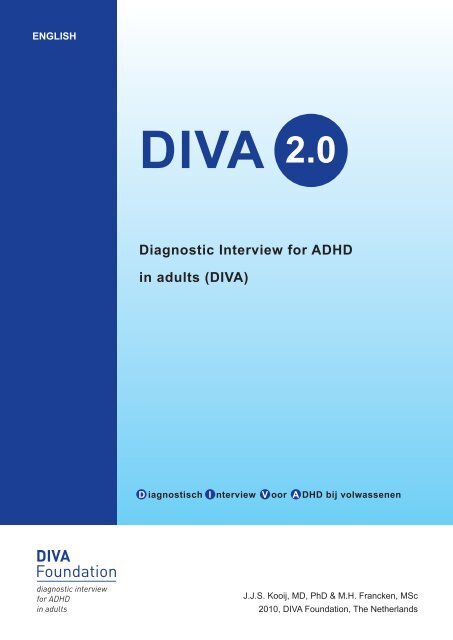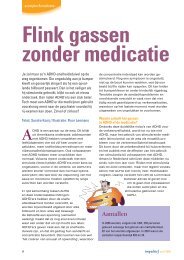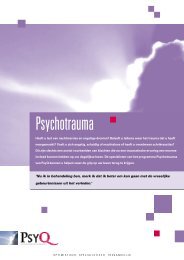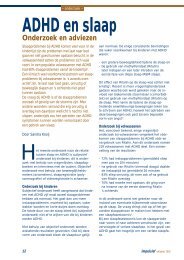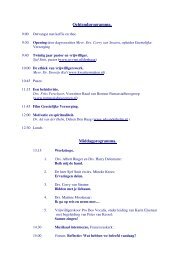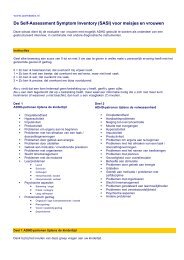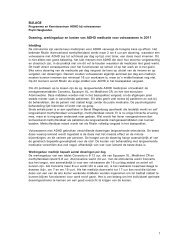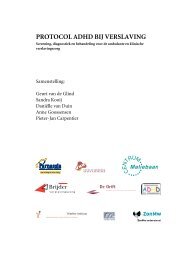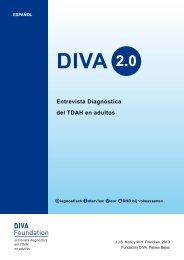Diagnostic Interview for ADHD in adults (DIVA) - PsyQ
Diagnostic Interview for ADHD in adults (DIVA) - PsyQ
Diagnostic Interview for ADHD in adults (DIVA) - PsyQ
Create successful ePaper yourself
Turn your PDF publications into a flip-book with our unique Google optimized e-Paper software.
ENGLISH<br />
diagnostic <strong>in</strong>terview<br />
<strong>for</strong> <strong>ADHD</strong><br />
<strong>in</strong> <strong>adults</strong><br />
<strong>DIVA</strong> 2.0<br />
<strong>Diagnostic</strong> <strong>Interview</strong> <strong>for</strong> <strong>ADHD</strong><br />
<strong>in</strong> <strong>adults</strong> (<strong>DIVA</strong>)<br />
D iagnostisch I nterview V oor A DHD bij volwassenen<br />
J.J.S. Kooij, MD, PhD & M.H. Francken, MSc<br />
2010, <strong>DIVA</strong> Foundation, The Netherlands
Colophon<br />
The <strong>Diagnostic</strong> <strong>Interview</strong> <strong>for</strong><br />
<strong>ADHD</strong> <strong>in</strong> <strong>adults</strong> (<strong>DIVA</strong>) is a<br />
publication of the <strong>DIVA</strong><br />
Foundation, The Hague,<br />
The Netherlands, August<br />
2010. The orig<strong>in</strong>al English<br />
translation by Vertaalbureau<br />
Boot was supported by<br />
Janssen-Cilag B.V. Backtranslation<br />
<strong>in</strong>to Dutch by<br />
Sietske Helder. Revison by<br />
dr. J.J.S. Kooij, <strong>DIVA</strong><br />
Foundation and Prof. Philip<br />
Asherson, Institute of<br />
Psychiatry, London.<br />
Repr<strong>in</strong>ted with permission<br />
from the <strong>Diagnostic</strong> and<br />
Statistical Manual of Mental<br />
Disorders, Text Revision,<br />
Fourth Edition (Copyright<br />
2000). American Psychiatric<br />
Association.<br />
This publication has been<br />
put together with care.<br />
However, over the course of<br />
time, parts of this publication<br />
might change. For that<br />
reason, no rights may be<br />
derived from this publication.<br />
For more <strong>in</strong><strong>for</strong>mation<br />
and future updates of the<br />
<strong>DIVA</strong> please visit<br />
www.divacenter.eu.<br />
Introduction<br />
Accord<strong>in</strong>g to the DSM-IV, ascerta<strong>in</strong><strong>in</strong>g the diagnosis of <strong>ADHD</strong> <strong>in</strong> <strong>adults</strong><br />
<strong>in</strong>volves determ<strong>in</strong><strong>in</strong>g the presence of <strong>ADHD</strong> symptoms dur<strong>in</strong>g both childhood<br />
and adulthood.<br />
The ma<strong>in</strong> requirements <strong>for</strong> the diagnosis are that the onset of <strong>ADHD</strong> symptoms<br />
occurred dur<strong>in</strong>g childhood and that this was followed by a lifelong<br />
persistence of the characteristic symptoms to the time of the current evaluation.<br />
The symptoms need to be associated with significant cl<strong>in</strong>ical or psychosocial<br />
impairments that affect the <strong>in</strong>dividual <strong>in</strong> two or more life situations 1 .<br />
Because <strong>ADHD</strong> <strong>in</strong> <strong>adults</strong> is a lifelong condition that starts <strong>in</strong> childhood, it is<br />
necessary to evaluate the symptoms, course and level of associated impairment<br />
<strong>in</strong> childhood, us<strong>in</strong>g a retrospective <strong>in</strong>terview <strong>for</strong> childhood behaviours.<br />
Whenever possible the <strong>in</strong><strong>for</strong>mation should be gathered from the patient and<br />
supplemented by <strong>in</strong><strong>for</strong>mation from <strong>in</strong><strong>for</strong>mants that knew the person as a child<br />
(usually parents or close relatives) 2 .<br />
The <strong>Diagnostic</strong> <strong>Interview</strong> <strong>for</strong> <strong>ADHD</strong> <strong>in</strong> Adults (<strong>DIVA</strong>)<br />
The <strong>DIVA</strong> is based on the DSM-IV criteria and is the first structured Dutch<br />
<strong>in</strong>terview <strong>for</strong> <strong>ADHD</strong> <strong>in</strong> <strong>adults</strong>. The <strong>DIVA</strong> has been developed by J.J.S. Kooij<br />
and M.H. Francken and is the successor of the earlier Semi-Structured<br />
<strong>Interview</strong> <strong>for</strong> <strong>ADHD</strong> <strong>in</strong> <strong>adults</strong> 2,3 .<br />
In order to simplify the evaluation of each of the 18 symptom criteria <strong>for</strong><br />
<strong>ADHD</strong>, <strong>in</strong> childhood and adulthood, the <strong>in</strong>terview provides a list of concrete<br />
and realistic examples, <strong>for</strong> both current and retrospective (childhood) behaviour.<br />
The examples are based on the common descriptions provided by adult<br />
patients <strong>in</strong> cl<strong>in</strong>ical practice. Examples are also provided of the types of<br />
impairments that are commonly associated with the symptoms <strong>in</strong> five areas of<br />
everyday life: work and education; relationships and family life; social contacts;<br />
free time and hobbies; self-confidence and self-image.<br />
Whenever possible the <strong>DIVA</strong> should be completed with <strong>adults</strong> <strong>in</strong> the presence<br />
of a partner and/or family member, to enable retrospective and collateral<br />
<strong>in</strong><strong>for</strong>mation to be ascerta<strong>in</strong>ed at the same time. The <strong>DIVA</strong> usually takes<br />
around one and a half hours to complete.<br />
The <strong>DIVA</strong> only asks about the core symptoms of <strong>ADHD</strong> required to make the<br />
DSM-IV diagnosis of <strong>ADHD</strong>, and does not ask about other co-occurr<strong>in</strong>g<br />
psychiatric symptoms, syndromes or disorders. However comorbidity is<br />
commonly seen <strong>in</strong> both children and <strong>adults</strong> with <strong>ADHD</strong>, <strong>in</strong> around 75% of<br />
cases. For this reason, it is important to complete a general psychiatric<br />
assessment to enquire about commonly co-occurr<strong>in</strong>g symptoms, syndromes<br />
and disorders. The most common mental health problems that accompany<br />
<strong>ADHD</strong> <strong>in</strong>clude anxiety, depression, bipolar disorder, substance abuse disorders<br />
and addiction, sleep problems and personality disorders, and all these<br />
should be <strong>in</strong>vestigated. This is needed to understand the full range of symptoms<br />
experienced by the <strong>in</strong>dividual with <strong>ADHD</strong>; and also <strong>for</strong> the differential<br />
diagnosis, to exclude other major psychiatric disorders as the primary cause<br />
of ‘<strong>ADHD</strong> symptoms’ <strong>in</strong> <strong>adults</strong> 2 .<br />
2 <strong>DIVA</strong> 2.0 <strong>Diagnostic</strong> <strong>Interview</strong> <strong>for</strong> <strong>ADHD</strong> <strong>in</strong> <strong>adults</strong>
Instructions <strong>for</strong> per<strong>for</strong>m<strong>in</strong>g the <strong>DIVA</strong><br />
The <strong>DIVA</strong> is divided <strong>in</strong>to three parts that are each applied<br />
to both childhood and adulthood:<br />
(1) The criteria <strong>for</strong> Attention Deficit (A1)<br />
(2) The criteria <strong>for</strong> Hyperactivity-Impulsivity (A2)<br />
(3) The Age of Onset and Impairment accounted <strong>for</strong> by<br />
<strong>ADHD</strong> symptoms<br />
Start with the first set of DSM-IV criteria <strong>for</strong> attention deficit<br />
(A1), followed by the second set of criteria <strong>for</strong> hyperactivity/impulsivity<br />
(A2). Ask about each of the 18 criteria <strong>in</strong><br />
turn. For each item take the follow<strong>in</strong>g approach:<br />
First ask about adulthood (symptoms present <strong>in</strong> the last<br />
6-months or more) and then ask about the same symptom<br />
<strong>in</strong> childhood (symptoms between the ages of 5 to 12<br />
years) 4-6 . Read each question fully and ask the person<br />
be<strong>in</strong>g <strong>in</strong>terviewed whether they recognise this problem<br />
and to provide examples. Patients will often give the same<br />
examples as those provided <strong>in</strong> the <strong>DIVA</strong>, which can then<br />
be ticked off as present. If they do not recognise the<br />
symptoms or you are not sure if their response is specific<br />
to the item <strong>in</strong> question, then use the examples, ask<strong>in</strong>g<br />
about each example <strong>in</strong> turn. For a problem behaviour or<br />
symptom to be scored as present, the problem should<br />
occur more frequently or at a more severe level than is<br />
usual <strong>in</strong> an age and IQ matched peer group, or to be<br />
closely associated with impairments. Tick off each of the<br />
examples that are described by the patient. If alternative<br />
examples that fit the criteria are given, make a note of<br />
these under “other”. To score an item as present it is not<br />
necessary to score all the examples as present, rather the<br />
aim is <strong>for</strong> the <strong>in</strong>vestigator to obta<strong>in</strong> a clear picture of the<br />
presence or absence of each criterion.<br />
For each criterion, ask whether the partner or family<br />
member agrees with this or can give further examples of<br />
problems that relate to each item. As a rule, the partner<br />
would report on adulthood and the family member (usually<br />
parent or older relative) on childhood. The cl<strong>in</strong>ician has to<br />
use cl<strong>in</strong>ical judgement <strong>in</strong> order to determ<strong>in</strong>e the most<br />
accurate answer. If the answers conflict with one another,<br />
the rule of thumb is that the patient is usually the best<br />
<strong>in</strong><strong>for</strong>mant 7 .<br />
The <strong>in</strong><strong>for</strong>mation received from the partner and family is<br />
ma<strong>in</strong>ly <strong>in</strong>tended to supplement the <strong>in</strong><strong>for</strong>mation obta<strong>in</strong>ed<br />
from the patient and to obta<strong>in</strong> an accurate account of both<br />
current and childhood behaviour; the <strong>in</strong><strong>for</strong>mant <strong>in</strong><strong>for</strong>mation<br />
is particularly useful <strong>for</strong> childhood s<strong>in</strong>ce many patients<br />
have difficulty recall<strong>in</strong>g their own behaviour retrospectively.<br />
Many people have a good recall <strong>for</strong> behaviour from<br />
<strong>DIVA</strong> 2.0 <strong>Diagnostic</strong> <strong>Interview</strong> <strong>for</strong> <strong>ADHD</strong> <strong>in</strong> <strong>adults</strong><br />
around the age of 10-12 years of age, but have difficulty<br />
<strong>for</strong> the pre-school years.<br />
For each criterion, the researcher should make a decision<br />
about the presence or absence <strong>in</strong> both stages of life,<br />
tak<strong>in</strong>g <strong>in</strong>to account the <strong>in</strong><strong>for</strong>mation from all the parties<br />
<strong>in</strong>volved. If collateral <strong>in</strong><strong>for</strong>mation cannot be obta<strong>in</strong>ed, the<br />
diagnosis should be based on the patient’s recall alone. If<br />
school reports are available, these can help to give an<br />
idea of the symptoms that were noticed <strong>in</strong> the classroom<br />
dur<strong>in</strong>g childhood and can be used to support the diagnosis.<br />
Symptoms are considered to be cl<strong>in</strong>ically relevant if<br />
they occurred to a more severe degree and/or more<br />
frequently than <strong>in</strong> the peer group or if they were impair<strong>in</strong>g<br />
to the <strong>in</strong>dividual.<br />
Age of onset and impairment<br />
The third section on Age of Onset and Impairment accounted<br />
<strong>for</strong> by the symptoms is an essential part of the<br />
diagnostic criteria. F<strong>in</strong>d out whether the patient has always<br />
had the symptoms and, if so, whether any symptoms were<br />
present be<strong>for</strong>e 7-years of age. If the symptoms did not<br />
commence till later <strong>in</strong> life, record the age of onset.<br />
Then ask about the examples <strong>for</strong> the different situations <strong>in</strong><br />
which impairment can occur, first <strong>in</strong> adulthood then <strong>in</strong><br />
childhood. Place a tick next to the examples that the<br />
patient recognises and <strong>in</strong>dicate whether the impairment is<br />
reported <strong>for</strong> two or more doma<strong>in</strong>s of function<strong>in</strong>g. For the<br />
disorder to be present, it should cause impairment <strong>in</strong> at<br />
least two situations, such as work and education; relationships<br />
and family life; social contacts; free time and<br />
hobbies; self-confidence and self-image, and be at least<br />
moderately impair<strong>in</strong>g.<br />
Summary of symptoms<br />
In the Summary of Symptoms of Attention Deficit (A) and<br />
Hyperactivity-Impulsivity (HI), <strong>in</strong>dicate which of the<br />
18 symptom criteria are present <strong>in</strong> both stages of life; and<br />
sum the number of criteria <strong>for</strong> <strong>in</strong>attention and hyperactivity/<br />
impulsivity separately.<br />
F<strong>in</strong>ally, <strong>in</strong>dicate on the Score Form whether six or more<br />
criteria are scored <strong>for</strong> each of the symptom doma<strong>in</strong>s of<br />
Attention Deficit (A) and Hyperactivity-Impulsivity (HI). For<br />
each doma<strong>in</strong>, <strong>in</strong>dicate whether there was evidence of a<br />
lifelong persistent course <strong>for</strong> the symptoms, whether the<br />
symptoms were associated with impairment, whether<br />
impairment occurred <strong>in</strong> at least two situations, and<br />
whether the symptoms might be better expla<strong>in</strong>ed by<br />
another psychiatric disorder. Indicate the degree to which<br />
3
the collateral <strong>in</strong><strong>for</strong>mation, and if applicable school reports,<br />
support the diagnosis. F<strong>in</strong>ally, conclude whether the<br />
diagnosis of <strong>ADHD</strong> can be made and which subtype (with<br />
DSM-IV code) applies.<br />
Explanation to be given be<strong>for</strong>ehand to the patient<br />
This <strong>in</strong>terview will be used to ask about the presence of<br />
<strong>ADHD</strong> symptoms that you experienced dur<strong>in</strong>g your<br />
childhood and adulthood. The questions are based on the<br />
official criteria <strong>for</strong> <strong>ADHD</strong> <strong>in</strong> the DSM-IV. For each question<br />
I will ask you whether you recognise the problem. To help<br />
you dur<strong>in</strong>g the <strong>in</strong>terview I will provide some examples of<br />
each symptom, that describe the way that children and<br />
<strong>adults</strong> often experience difficulties related to each of the<br />
symptoms of <strong>ADHD</strong>. First of all, you will be asked the<br />
questions, then your partner and family members (if<br />
present) will be asked the same questions. Your partner<br />
will most likely have known you only s<strong>in</strong>ce adulthood and<br />
will be asked questions about the period of your life that<br />
he or she knew you <strong>for</strong>; your family will have a better idea<br />
of your behaviour dur<strong>in</strong>g childhood. Both stages of your<br />
life need to be <strong>in</strong>vestigated <strong>in</strong> order to be able to establish<br />
the diagnosis of <strong>ADHD</strong>.<br />
References<br />
1. American Psychiatric Association (APA):<br />
<strong>Diagnostic</strong> and Statistical Manual of Mental<br />
Disorders, Text Revision, Fourth Edition.<br />
Wash<strong>in</strong>gton DC, 2000.<br />
2. <strong>Diagnostic</strong> <strong>Interview</strong> <strong>for</strong> <strong>ADHD</strong> <strong>in</strong> Adults 2.0<br />
(<strong>DIVA</strong> 2.0), <strong>in</strong>: Kooij, JJS. Adult <strong>ADHD</strong>. <strong>Diagnostic</strong><br />
assessment and treatment. Pearson Assessment<br />
and In<strong>for</strong>mation BV, Amsterdam, 2010.<br />
3. Kooij, JJS, Francken MH: Diagnostisch <strong>Interview</strong><br />
Voor <strong>ADHD</strong> (<strong>DIVA</strong>) bij volwassenen. Onl<strong>in</strong>e<br />
available at www.kenniscentrumadhdbijvolwassenen.nl,<br />
2007 and published <strong>in</strong> English <strong>in</strong><br />
reference 2.<br />
4. Applegate B, Lahey BB, Hart EL, Biederman J,<br />
Hynd GW, Barkley RA, Ollendick T, Frick PJ,<br />
Greenhill L, McBurnett K, Newcorn JH, Kerdyk<br />
L, Garf<strong>in</strong>kel B, Waldman I, Shaffer D: Validity of<br />
the age-of-onset criterion <strong>for</strong> <strong>ADHD</strong>: a report<br />
from the DSM-IV field trials. J Am Acad Child<br />
Adolesc Psychiatry 1997; 36(9):1211-21<br />
5. Barkley RA, Biederman J: Toward a broader<br />
def<strong>in</strong>ition of the age-of-onset criterion <strong>for</strong><br />
attention-deficit hyperactivity disorder. J Am<br />
Acad Child Adolesc Psychiatry 1997;<br />
36(9):1204-10<br />
6. Faraone SV, Biederman J, Spencer T, Mick E,<br />
Murray K, Petty C, Adamson JJ, Monuteaux<br />
MC: Diagnos<strong>in</strong>g adult attention deficit hyperactivity<br />
disorder: are late onset and subthreshold<br />
diagnoses valid? Am J Psychiatry<br />
2006;163(10):1720-9<br />
7. Kooij JJS, Boonstra AM, Willemsen-Sw<strong>in</strong>kels<br />
SHN, Bekker EM, Noord Id, Buitelaar JL:<br />
Reliability, validity, and utility of <strong>in</strong>struments <strong>for</strong><br />
self-report and <strong>in</strong><strong>for</strong>mant report regard<strong>in</strong>g<br />
symptoms of Attention-Deficit/Hyperactivity<br />
Disorder (<strong>ADHD</strong>) <strong>in</strong> adult patients. J Atten<br />
Disorders 2008; 11(4):445-458<br />
Repr<strong>in</strong>ted with permission from the <strong>Diagnostic</strong> and<br />
Statistical Manual of Mental Disorders, Text Revision,<br />
Fourth Edition (Copyright 2000). American<br />
Psychiatric Association.<br />
4 <strong>DIVA</strong> 2.0 <strong>Diagnostic</strong> <strong>Interview</strong> <strong>for</strong> <strong>ADHD</strong> <strong>in</strong> <strong>adults</strong>
Name of the patient<br />
Date of birth<br />
Sex:<br />
Date of <strong>in</strong>terview<br />
Name of researcher<br />
Patient number<br />
Part 1: Symptoms of attention-deficit (DSM-IV criterion A1)<br />
Instructions: the symptoms <strong>in</strong> adulthood have to have been present <strong>for</strong> at least 6 months. The symptoms <strong>in</strong> childhood<br />
relate to the age of 5-12 years. For a symptom to be ascribed to <strong>ADHD</strong> it should have a chronic trait-like course and<br />
should not be episodic.<br />
A1<br />
❑ M / ❑ F<br />
Do you often fail to give close attention to detail, or do you make careless mistakes <strong>in</strong> your work or<br />
dur<strong>in</strong>g other activities? And how was that dur<strong>in</strong>g childhood?<br />
Examples dur<strong>in</strong>g adulthood:<br />
❑ Makes careless mistakes<br />
❑ Works slowly to avoid mistakes<br />
❑ Does not read <strong>in</strong>structions carefully<br />
❑ Difficulty work<strong>in</strong>g <strong>in</strong> a detailed way<br />
❑ Too much time needed to complete detailed tasks<br />
❑ Gets easily bogged down by details<br />
❑ Works too quickly and there<strong>for</strong>e makes mistakes<br />
❑ Other:<br />
Symptom present: ❑ Yes / ❑ No<br />
<strong>DIVA</strong> 2.0 <strong>Diagnostic</strong> <strong>Interview</strong> <strong>for</strong> <strong>ADHD</strong> <strong>in</strong> <strong>adults</strong><br />
Examples dur<strong>in</strong>g childhood:<br />
❑ Careless mistakes <strong>in</strong> schoolwork<br />
❑ Mistakes made by not read<strong>in</strong>g questions properly<br />
❑ Leaves questions unanswered by not read<strong>in</strong>g them<br />
properly<br />
❑ Leaves the reverse side of a test unanswered<br />
❑ Others comment about careless work<br />
❑ Not check<strong>in</strong>g the answers <strong>in</strong> homework<br />
❑ Too much time needed to complete detailed tasks<br />
❑ Other:<br />
Symptom present: ❑ Yes / ❑ No<br />
5
A2<br />
Do you often f<strong>in</strong>d it difficult to susta<strong>in</strong> your attention on tasks? And how was that dur<strong>in</strong>g childhood?<br />
Examples dur<strong>in</strong>g adulthood:<br />
❑ Not able to keep attention on tasks <strong>for</strong> long*<br />
❑ Quickly distracted by own thoughts or associations<br />
❑ F<strong>in</strong>ds it difficult to watch a film through to the end, or to<br />
read a book*<br />
❑ Quickly becomes bored with th<strong>in</strong>gs*<br />
❑ Asks questions about subjects that have already been<br />
discussed<br />
❑ Other:<br />
*Unless the subject is found to be really <strong>in</strong>terest<strong>in</strong>g (e.g.<br />
computer or hobby)<br />
Symptom present: ❑ Yes / ❑ No<br />
A3<br />
Does it often seem as though you are not listen<strong>in</strong>g when you are spoken to directly? And how was that<br />
dur<strong>in</strong>g childhood?<br />
Examples dur<strong>in</strong>g adulthood:<br />
❑ Dreamy or preoccupied<br />
❑ Difficulty concentrat<strong>in</strong>g on a conversation<br />
❑ Afterwards, not know<strong>in</strong>g what a conversation was<br />
about<br />
❑ Often chang<strong>in</strong>g the subject of the conversation<br />
❑ Others say<strong>in</strong>g that your thoughts are somewhere else<br />
❑ Other:<br />
Symptom present: ❑ Yes / ❑ No<br />
Examples dur<strong>in</strong>g childhood:<br />
❑ Difficulty keep<strong>in</strong>g attention on schoolwork<br />
❑ Difficulty keep<strong>in</strong>g attention on play*<br />
❑ Easily distracted<br />
❑ Difficulty concentrat<strong>in</strong>g*<br />
❑ Need<strong>in</strong>g structure to avoid becom<strong>in</strong>g distracted<br />
❑ Quickly becom<strong>in</strong>g bored of activities*<br />
❑ Other:<br />
*Unless the subject is found to be really <strong>in</strong>terest<strong>in</strong>g (e.g.<br />
computer or hobby)<br />
Symptom present: ❑ Yes / ❑ No<br />
Examples dur<strong>in</strong>g childhood:<br />
❑ Not know<strong>in</strong>g what parents/teachers have said<br />
❑ Dreamy or preoccupied<br />
❑ Only listen<strong>in</strong>g dur<strong>in</strong>g eye contact or when a voice is<br />
raised<br />
❑ Often hav<strong>in</strong>g to be addressed aga<strong>in</strong><br />
❑ Questions hav<strong>in</strong>g to be repeated<br />
❑ Other:<br />
Symptom present: ❑ Yes / ❑ No<br />
6 <strong>DIVA</strong> 2.0 <strong>Diagnostic</strong> <strong>Interview</strong> <strong>for</strong> <strong>ADHD</strong> <strong>in</strong> <strong>adults</strong>
A4<br />
Do you often fail to follow through on <strong>in</strong>structions and do you often fail to f<strong>in</strong>ish jobs or fail to meet obligations<br />
at work? And how was that dur<strong>in</strong>g childhood (when do<strong>in</strong>g schoolwork as opposed to when at work)?<br />
Examples dur<strong>in</strong>g adulthood:<br />
❑ Does th<strong>in</strong>gs that are muddled up together without<br />
complet<strong>in</strong>g them<br />
❑ Difficulty complet<strong>in</strong>g tasks once the novelty has worn off<br />
❑ Need<strong>in</strong>g a time limit to complete tasks<br />
❑ Difficulty complet<strong>in</strong>g adm<strong>in</strong>istrative tasks<br />
❑ Difficultly follow<strong>in</strong>g <strong>in</strong>structions from a manual<br />
❑ Other:<br />
Symptom present: ❑ Yes / ❑ No<br />
A5<br />
Do you often f<strong>in</strong>d it difficult to organise tasks and activities? And how was that dur<strong>in</strong>g childhood?<br />
Examples dur<strong>in</strong>g adulthood:<br />
❑ Difficultly with plann<strong>in</strong>g activities of daily life<br />
❑ House and/or workplace are disorganised<br />
❑ Plann<strong>in</strong>g too many tasks or non-efficient plann<strong>in</strong>g<br />
❑ Regularly book<strong>in</strong>g th<strong>in</strong>gs to take place at the same<br />
time (double-book<strong>in</strong>g)<br />
❑ Arriv<strong>in</strong>g late<br />
❑ Not able to use an agenda or diary consistently<br />
❑ Inflexible because of the need to keep to schedules<br />
❑ Poor sense of time<br />
❑ Creat<strong>in</strong>g schedules but not us<strong>in</strong>g them<br />
❑ Need<strong>in</strong>g other people to structure th<strong>in</strong>gs<br />
❑ Other:<br />
Symptom present: ❑ Yes / ❑ No<br />
<strong>DIVA</strong> 2.0 <strong>Diagnostic</strong> <strong>Interview</strong> <strong>for</strong> <strong>ADHD</strong> <strong>in</strong> <strong>adults</strong><br />
Examples dur<strong>in</strong>g childhood:<br />
❑ Difficulty follow<strong>in</strong>g <strong>in</strong>structions<br />
❑ Difficulty with <strong>in</strong>structions <strong>in</strong>volv<strong>in</strong>g more than one step<br />
❑ Not complet<strong>in</strong>g th<strong>in</strong>gs<br />
❑ Not complet<strong>in</strong>g homework or hand<strong>in</strong>g it <strong>in</strong><br />
❑ Need<strong>in</strong>g a lot of structure <strong>in</strong> order to complete tasks<br />
❑ Other:<br />
Symptom present: ❑ Yes / ❑ No<br />
Examples dur<strong>in</strong>g childhood:<br />
❑ Difficultly be<strong>in</strong>g ready on time<br />
❑ Messy room or desk<br />
❑ Difficultly play<strong>in</strong>g alone<br />
❑ Difficulty plann<strong>in</strong>g tasks or homework<br />
❑ Do<strong>in</strong>g th<strong>in</strong>gs <strong>in</strong> a muddled way<br />
❑ Arriv<strong>in</strong>g late<br />
❑ Poor sense of time<br />
❑ Difficulty keep<strong>in</strong>g himself/herself enterta<strong>in</strong>ed<br />
❑ Other:<br />
Symptom present: ❑ Yes / ❑ No<br />
7
A6<br />
Do you often avoid (or do you have an aversion to, or are you unwill<strong>in</strong>g to do) tasks which require<br />
susta<strong>in</strong>ed mental ef<strong>for</strong>t? And how was that dur<strong>in</strong>g childhood?<br />
Examples dur<strong>in</strong>g adulthood:<br />
❑ Do the easiest or nicest th<strong>in</strong>gs first of all<br />
❑ Often postpone bor<strong>in</strong>g or difficult tasks<br />
❑ Postpone tasks so that deadl<strong>in</strong>es are missed<br />
❑ Avoid monotonous work, such as adm<strong>in</strong>istration<br />
❑ Do not like read<strong>in</strong>g due to mental ef<strong>for</strong>t<br />
❑ Avoidance of tasks that require a lot of concentration<br />
❑ Other:<br />
Symptom present: ❑ Yes / ❑ No<br />
A7<br />
Do you often lose th<strong>in</strong>gs that are needed <strong>for</strong> tasks or activities? And how was that dur<strong>in</strong>g childhood?<br />
Examples dur<strong>in</strong>g adulthood:<br />
❑ Mislays wallet, keys, or agenda<br />
❑ Often leaves th<strong>in</strong>gs beh<strong>in</strong>d<br />
❑ Loses papers <strong>for</strong> work<br />
❑ Loses a lot of time search<strong>in</strong>g <strong>for</strong> th<strong>in</strong>gs<br />
❑ Gets <strong>in</strong> a panic if other people move th<strong>in</strong>gs around<br />
❑ Stores th<strong>in</strong>gs away <strong>in</strong> the wrong place<br />
❑ Loses notes, lists or telephone numbers<br />
❑ Other:<br />
Symptom present: ❑ Yes / ❑ No<br />
Examples dur<strong>in</strong>g childhood:<br />
❑ Avoidance of homework or has an aversion to this<br />
❑ Reads few books or does not feel like read<strong>in</strong>g due to<br />
mental ef<strong>for</strong>t<br />
❑ Avoidance of tasks that require a lot of concentration<br />
❑ Aversion to school subjects that require a lot of<br />
concentration<br />
❑ Often postpones bor<strong>in</strong>g or difficult tasks.<br />
❑ Other:<br />
Symptom present: ❑ Yes / ❑ No<br />
Examples dur<strong>in</strong>g childhood:<br />
❑ Loses diaries, pens, gym kit or other items<br />
❑ Mislays toys, cloth<strong>in</strong>g, or homework<br />
❑ Spends a lot of time search<strong>in</strong>g <strong>for</strong> th<strong>in</strong>gs<br />
❑ Gets <strong>in</strong> a panic if other people move th<strong>in</strong>gs around<br />
❑ Comments from parents and/or teacher about th<strong>in</strong>gs<br />
be<strong>in</strong>g lost<br />
❑ Other:<br />
Symptom present: ❑ Yes / ❑ No<br />
8 <strong>DIVA</strong> 2.0 <strong>Diagnostic</strong> <strong>Interview</strong> <strong>for</strong> <strong>ADHD</strong> <strong>in</strong> <strong>adults</strong>
A8<br />
Are you often easily distracted by external stimuli? And how was that dur<strong>in</strong>g childhood?<br />
Examples dur<strong>in</strong>g adulthood:<br />
❑ Difficulty shutt<strong>in</strong>g off from external stimuli<br />
❑ After be<strong>in</strong>g distracted, difficult to pick up the thread aga<strong>in</strong><br />
❑ Easily distracted by noises or events<br />
❑ Easily distracted by the conversations of others<br />
❑ Difficulty <strong>in</strong> filter<strong>in</strong>g and/or select<strong>in</strong>g <strong>in</strong><strong>for</strong>mation<br />
❑ Other:<br />
Symptom present: ❑ Yes / ❑ No<br />
A9<br />
Are you often <strong>for</strong>getful dur<strong>in</strong>g daily activities? And how was that dur<strong>in</strong>g childhood?<br />
Examples dur<strong>in</strong>g adulthood:<br />
❑ Forgets appo<strong>in</strong>tments or other obligations<br />
❑ Forgets keys, agenda etc.<br />
❑ Needs frequent rem<strong>in</strong>ders <strong>for</strong> appo<strong>in</strong>tments<br />
❑ Return<strong>in</strong>g home to fetch <strong>for</strong>gotten th<strong>in</strong>gs<br />
❑ Rigid use of lists to make sure th<strong>in</strong>gs aren’t <strong>for</strong>gotten<br />
❑ Forgets to keep or look at daily agenda<br />
❑ Other:<br />
Symptom present: ❑ Yes / ❑ No<br />
Supplement criterion A<br />
<strong>DIVA</strong> 2.0 <strong>Diagnostic</strong> <strong>Interview</strong> <strong>for</strong> <strong>ADHD</strong> <strong>in</strong> <strong>adults</strong><br />
Examples dur<strong>in</strong>g childhood:<br />
❑ In the classroom, often look<strong>in</strong>g outside<br />
❑ Easily distracted by noises or events<br />
❑ After be<strong>in</strong>g distracted, has difficultly pick<strong>in</strong>g up the<br />
thread aga<strong>in</strong><br />
❑ Other:<br />
Symptom present: ❑ Yes / ❑ No<br />
Examples dur<strong>in</strong>g childhood:<br />
❑ Forgets appo<strong>in</strong>tments or <strong>in</strong>structions<br />
❑ Has to be frequently rem<strong>in</strong>ded of th<strong>in</strong>gs<br />
❑ Half-way through a task, <strong>for</strong>gett<strong>in</strong>g what has to be done<br />
❑ Forgets to take th<strong>in</strong>gs to school<br />
❑ Leav<strong>in</strong>g th<strong>in</strong>gs beh<strong>in</strong>d at school or at friends’ houses<br />
❑ Other:<br />
Symptom present: ❑ Yes / ❑ No<br />
Adulthood:<br />
Do you have more of these symptoms of attention deficit than other people, or do you experience these more frequently<br />
than other people of your age?<br />
❑ Yes / ❑ No<br />
Childhood:<br />
Did you have more of these symptoms of attention deficit than other children of your age, or did you experience these<br />
more frequently than other children of your age?<br />
❑ Yes / ❑ No<br />
9
Part 2: Symptoms of hyperactivity-impulsivity<br />
(DSM-IV criterion A2)<br />
Instructions: the symptoms <strong>in</strong> adulthood have to have been present <strong>for</strong> at least 6 months. The symptoms <strong>in</strong> childhood<br />
relate to the age of 5-12 years. For a symptom to be ascribed to <strong>ADHD</strong> it should have a chronic trait-like course and<br />
should not be episodic.<br />
H/I 1<br />
H/I 2<br />
Do you often move your hands or feet <strong>in</strong> a restless manner, or do you often fidget <strong>in</strong> your chair?<br />
And how was that dur<strong>in</strong>g childhood?<br />
Examples dur<strong>in</strong>g adulthood:<br />
❑ Difficulty sitt<strong>in</strong>g still<br />
❑ Fidgets with the legs<br />
❑ Tapp<strong>in</strong>g with a pen or play<strong>in</strong>g with someth<strong>in</strong>g<br />
❑ Fiddl<strong>in</strong>g with hair or bit<strong>in</strong>g nails<br />
❑ Able to control restlessness, but feels stressed as a<br />
result<br />
❑ Other:<br />
Symptom present: ❑ Yes / ❑ No<br />
Do you often stand up <strong>in</strong> situations where the expectation is that you should rema<strong>in</strong> <strong>in</strong> your seat?<br />
And how was that dur<strong>in</strong>g childhood?<br />
Examples dur<strong>in</strong>g adulthood:<br />
❑ Avoids symposiums, lectures, church etc.<br />
❑ Prefers to walk around rather than sit<br />
❑ Never sits still <strong>for</strong> long, always mov<strong>in</strong>g around<br />
❑ Stressed ow<strong>in</strong>g to the difficulty of sitt<strong>in</strong>g still<br />
❑ Makes excuses <strong>in</strong> order to be able to walk around<br />
❑ Other:<br />
Symptom present: ❑ Yes / ❑ No<br />
Examples dur<strong>in</strong>g childhood:<br />
❑ Parents often said “sit still” or similar<br />
❑ Fidgets with the legs<br />
❑ Tapp<strong>in</strong>g with a pen or play<strong>in</strong>g with someth<strong>in</strong>g<br />
❑ Fiddl<strong>in</strong>g with hair or bit<strong>in</strong>g nails<br />
❑ Unable to rema<strong>in</strong> seated <strong>in</strong> a chair <strong>in</strong> a relaxed manner<br />
❑ Able to control restlessness, but feels stressed as a result<br />
❑ Other:<br />
Symptom present: ❑ Yes / ❑ No<br />
Examples dur<strong>in</strong>g childhood:<br />
❑ Often stands up while eat<strong>in</strong>g or <strong>in</strong> the classroom<br />
❑ F<strong>in</strong>ds it very difficult to stay seated at school or dur<strong>in</strong>g<br />
meals<br />
❑ Be<strong>in</strong>g told to rema<strong>in</strong> seated<br />
❑ Mak<strong>in</strong>g excuses <strong>in</strong> order to walk around<br />
❑ Other:<br />
Symptom present: ❑ Yes / ❑ No<br />
10 <strong>DIVA</strong> 2.0 <strong>Diagnostic</strong> <strong>Interview</strong> <strong>for</strong> <strong>ADHD</strong> <strong>in</strong> <strong>adults</strong>
H/I 3<br />
Examples dur<strong>in</strong>g adulthood:<br />
Do you often feel restless? And how was that dur<strong>in</strong>g childhood?<br />
❑ Feel<strong>in</strong>g restless or agitated <strong>in</strong>side<br />
❑ Constantly hav<strong>in</strong>g the feel<strong>in</strong>g that you have to be do<strong>in</strong>g<br />
someth<strong>in</strong>g<br />
❑ F<strong>in</strong>d<strong>in</strong>g it hard to relax<br />
❑ Other:<br />
Symptom present: ❑ Yes / ❑ No<br />
H/I 4<br />
Do you often f<strong>in</strong>d it difficult to engage <strong>in</strong> leisure activities quietly? And how was that dur<strong>in</strong>g<br />
childhood?<br />
Examples dur<strong>in</strong>g adulthood:<br />
❑ Talks dur<strong>in</strong>g activities when this is not appropriate<br />
❑ Becom<strong>in</strong>g quickly too cocky <strong>in</strong> public<br />
❑ Be<strong>in</strong>g loud <strong>in</strong> all k<strong>in</strong>ds of situations<br />
❑ Difficulty do<strong>in</strong>g activities quietly<br />
❑ Difficultly <strong>in</strong> speak<strong>in</strong>g softly<br />
❑ Other:<br />
Symptom present: ❑ Yes / ❑ No<br />
<strong>DIVA</strong> 2.0 <strong>Diagnostic</strong> <strong>Interview</strong> <strong>for</strong> <strong>ADHD</strong> <strong>in</strong> <strong>adults</strong><br />
Examples dur<strong>in</strong>g childhood:<br />
❑ Always runn<strong>in</strong>g around<br />
❑ Climb<strong>in</strong>g on furniture, or jump<strong>in</strong>g on the sofa<br />
❑ Climb<strong>in</strong>g <strong>in</strong> trees<br />
❑ Feel<strong>in</strong>g restless <strong>in</strong>side<br />
❑ Other:<br />
Symptom present: ❑ Yes / ❑ No<br />
Examples dur<strong>in</strong>g childhood:<br />
❑ Be<strong>in</strong>g loud-spoken dur<strong>in</strong>g play or <strong>in</strong> the classroom<br />
❑ Unable to watch TV or films quietly<br />
❑ Asked to be quieter or calm down<br />
❑ Becom<strong>in</strong>g quickly too cocky <strong>in</strong> public<br />
❑ Other:<br />
Symptom present: ❑ Yes / ❑ No<br />
11
H/I 5<br />
Are you often on the go or do you often act as if “driven by a motor”? And how was that dur<strong>in</strong>g<br />
childhood?<br />
Examples dur<strong>in</strong>g adulthood:<br />
❑ Always busy do<strong>in</strong>g someth<strong>in</strong>g<br />
❑ Has too much energy, always on the move<br />
❑ Stepp<strong>in</strong>g over own boundaries<br />
❑ F<strong>in</strong>ds it difficult to let th<strong>in</strong>gs go, excessively driven<br />
❑ Other:<br />
Symptom present: ❑ Yes / ❑ No<br />
H/I 6<br />
Examples dur<strong>in</strong>g adulthood:<br />
Do you often talk excessively? And how was that dur<strong>in</strong>g childhood?<br />
❑ So busy talk<strong>in</strong>g that other people f<strong>in</strong>d it tir<strong>in</strong>g<br />
❑ Known to be an <strong>in</strong>cessant talker<br />
❑ F<strong>in</strong>ds it difficult to stop talk<strong>in</strong>g<br />
❑ Tendency to talk too much<br />
❑ Not giv<strong>in</strong>g others room to <strong>in</strong>terject dur<strong>in</strong>g a conversation<br />
❑ Need<strong>in</strong>g a lot of words to say someth<strong>in</strong>g<br />
❑ Other:<br />
Symptom present: ❑ Yes / ❑ No<br />
Examples dur<strong>in</strong>g childhood:<br />
❑ Constantly busy<br />
❑ Excessively active at school and at home<br />
❑ Has lots of energy<br />
❑ Always on the go, excessively driven<br />
❑ Other:<br />
Symptom present: ❑ Yes / ❑ No<br />
Examples dur<strong>in</strong>g childhood:<br />
❑ Known as a chatterbox<br />
❑ Teachers and parents often ask you to be quiet<br />
❑ Comments <strong>in</strong> school reports about talk<strong>in</strong>g too much<br />
❑ Be<strong>in</strong>g punished <strong>for</strong> talk<strong>in</strong>g too much<br />
❑ Keep<strong>in</strong>g others from do<strong>in</strong>g schoolwork by talk<strong>in</strong>g too<br />
much<br />
❑ Not giv<strong>in</strong>g others room dur<strong>in</strong>g a conversation<br />
❑ Other:<br />
Symptom present: ❑ Yes / ❑ No<br />
12 <strong>DIVA</strong> 2.0 <strong>Diagnostic</strong> <strong>Interview</strong> <strong>for</strong> <strong>ADHD</strong> <strong>in</strong> <strong>adults</strong>
H/I 7<br />
Do you often give the answer be<strong>for</strong>e questions have been completed? And how was that dur<strong>in</strong>g<br />
childhood?<br />
Examples dur<strong>in</strong>g adulthood:<br />
❑ Be<strong>in</strong>g a blabbermouth, say<strong>in</strong>g what you th<strong>in</strong>k<br />
❑ Say<strong>in</strong>g th<strong>in</strong>gs without th<strong>in</strong>k<strong>in</strong>g first<br />
❑ Giv<strong>in</strong>g people answers be<strong>for</strong>e they have f<strong>in</strong>ished<br />
speak<strong>in</strong>g<br />
❑ Complet<strong>in</strong>g other people’s words<br />
❑ Be<strong>in</strong>g tactless<br />
❑ Other:<br />
Symptom present: ❑ Yes / ❑ No<br />
H/I 8<br />
Examples dur<strong>in</strong>g adulthood:<br />
Do you often f<strong>in</strong>d it difficult to await your turn? And how was that dur<strong>in</strong>g childhood?<br />
❑ Difficulty wait<strong>in</strong>g <strong>in</strong> a queue, jump<strong>in</strong>g the queue<br />
❑ Difficulty <strong>in</strong> patiently wait<strong>in</strong>g <strong>in</strong> the traffic/traffic jams<br />
❑ Difficulty wait<strong>in</strong>g your turn dur<strong>in</strong>g conversations<br />
❑ Be<strong>in</strong>g impatient<br />
❑ Quickly start<strong>in</strong>g relationships/jobs, or end<strong>in</strong>g/leav<strong>in</strong>g<br />
these because of impatience<br />
❑ Other:<br />
Symptom present: ❑ Yes / ❑ No<br />
<strong>DIVA</strong> 2.0 <strong>Diagnostic</strong> <strong>Interview</strong> <strong>for</strong> <strong>ADHD</strong> <strong>in</strong> <strong>adults</strong><br />
Examples dur<strong>in</strong>g childhood:<br />
❑ Be<strong>in</strong>g a blabbermouth, say<strong>in</strong>g th<strong>in</strong>gs without th<strong>in</strong>k<strong>in</strong>g<br />
first<br />
❑ Wants to be the first to answer questions at school<br />
❑ Blurts out an answer even if it is wrong<br />
❑ Interrupts others be<strong>for</strong>e sentences are f<strong>in</strong>ished<br />
❑ Com<strong>in</strong>g across as be<strong>in</strong>g tactless<br />
❑ Other:<br />
Symptom present: ❑ Yes / ❑ No<br />
Examples dur<strong>in</strong>g childhood:<br />
❑ Difficultly wait<strong>in</strong>g turn <strong>in</strong> group activities<br />
❑ Difficultly wait<strong>in</strong>g turn <strong>in</strong> the classroom<br />
❑ Always be<strong>in</strong>g the first to talk or act<br />
❑ Becomes quickly impatient<br />
❑ Crosses the road without look<strong>in</strong>g<br />
❑ Other:<br />
Symptom present: ❑ Yes / ❑ No<br />
13
H/I 9<br />
Do you often <strong>in</strong>terrupt the activities of others, or <strong>in</strong>trude on others? And how was that dur<strong>in</strong>g<br />
childhood?<br />
Examples dur<strong>in</strong>g adulthood:<br />
❑ Be<strong>in</strong>g quick to <strong>in</strong>terfere with others<br />
❑ Interrupts others<br />
❑ Disturbes other people’s activities without be<strong>in</strong>g asked<br />
❑ Comments from others about <strong>in</strong>terference<br />
❑ Difficulty respect<strong>in</strong>g the boundaries of others<br />
❑ Hav<strong>in</strong>g an op<strong>in</strong>ion about everyth<strong>in</strong>g and immediately<br />
express<strong>in</strong>g this<br />
❑ Other:<br />
Symptom present: ❑ Yes / ❑ No<br />
Supplement criterion A<br />
Examples dur<strong>in</strong>g childhood:<br />
❑ Imp<strong>in</strong>ges on the games of others<br />
❑ Interrupts the conversations of others<br />
❑ Reacts to everyth<strong>in</strong>g<br />
❑ Unable to wait<br />
❑ Other:<br />
Symptom present: ❑ Yes / ❑ No<br />
Adulthood:<br />
Do you have more of these symptoms of hyperactivity/impulsivity than other people, or do you experience these more<br />
frequently than other people?<br />
❑ Yes / ❑ No<br />
Childhood:<br />
Did you have more of these symptoms of hyperactivity/impulsivity than other children of your age, or did you experience<br />
these more frequently than other children of your age?<br />
❑ Yes / ❑ No<br />
Part 3: Impairment on account of the symptoms<br />
(DSM-IV criteria B, C and D)<br />
Criterion B<br />
Have you always had these symptoms of attention deficit and/or hyperactivity/impulsivity?<br />
❑ Yes (a number of symptoms were present prior to the 7th year of age).<br />
❑ N o<br />
If no is answered above, start<strong>in</strong>g as from year of age.<br />
14 <strong>DIVA</strong> 2.0 <strong>Diagnostic</strong> <strong>Interview</strong> <strong>for</strong> <strong>ADHD</strong> <strong>in</strong> <strong>adults</strong>
Criterion C<br />
In which areas do you have / have you had problems with these symptoms?<br />
Adulthood<br />
Work/education<br />
❑ Did not complete education/tra<strong>in</strong><strong>in</strong>g needed <strong>for</strong> work<br />
❑ Work below level of education<br />
❑ Tire quickly of a workplace<br />
❑ Pattern of many short-last<strong>in</strong>g jobs<br />
❑ Difficulty with adm<strong>in</strong>istrative work/plann<strong>in</strong>g<br />
❑ Not achiev<strong>in</strong>g promotions<br />
❑ Under-per<strong>for</strong>m<strong>in</strong>g at work<br />
❑ Left work follow<strong>in</strong>g arguments or dismissal<br />
❑ Sickness benefits/disability benefit as a result of<br />
symptoms<br />
❑ Limited impairment through compensation of high IQ<br />
❑ Limited impairment through compensation of external<br />
structure<br />
❑ Other<br />
Relationship and/or family<br />
❑ Tire quickly of relationships<br />
❑ Impulsively commenc<strong>in</strong>g/end<strong>in</strong>g relationships<br />
❑ Unequal partner relationship ow<strong>in</strong>g to symptoms<br />
❑ Relationship problems, lots of arguments, lack of<br />
<strong>in</strong>timacy<br />
❑ Divorced ow<strong>in</strong>g to symptoms<br />
❑ Problems with sexuality as a result of symptoms<br />
❑ Problems with upbr<strong>in</strong>g<strong>in</strong>g as a result of symptoms<br />
❑ Difficulty with housekeep<strong>in</strong>g and/or adm<strong>in</strong>istration<br />
❑ F<strong>in</strong>ancial problems or gambl<strong>in</strong>g<br />
❑ Not dar<strong>in</strong>g to start a relationship<br />
❑ Other:<br />
<strong>DIVA</strong> 2.0 <strong>Diagnostic</strong> <strong>Interview</strong> <strong>for</strong> <strong>ADHD</strong> <strong>in</strong> <strong>adults</strong><br />
Childhood and adolescence<br />
Education<br />
❑ Lower educational level than expected based on IQ<br />
❑ Stay<strong>in</strong>g back (repeat<strong>in</strong>g classes) as a result of<br />
concentration problems<br />
❑ Education not completed / rejected from school<br />
❑ Took much longer to complete education than usual<br />
❑ Achieved education suited to IQ with a lot of ef<strong>for</strong>t<br />
❑ Difficulty do<strong>in</strong>g homework<br />
❑ Followed special education on account of symptoms<br />
❑ Comments from teachers about behaviour or concentration<br />
❑ Limited impairment through compensation of high IQ<br />
❑ Limited impairment through compensation of external<br />
structure<br />
❑ Other:<br />
Family<br />
❑ Frequent arguments with brothers or sisters<br />
❑ Frequent punishment or hid<strong>in</strong>g<br />
❑ Little contact with family on account of conflicts<br />
❑ Required structure from parents <strong>for</strong> a longer period<br />
than would normally be the case<br />
❑ Other:<br />
15
Adulthood (cont<strong>in</strong>uance) Childhood and adolescence (cont<strong>in</strong>uance)<br />
Social contacts<br />
❑ Tire quickly of social contacts<br />
❑ Difficultly ma<strong>in</strong>ta<strong>in</strong><strong>in</strong>g social contacts<br />
❑ Conflicts as a result of communication problems<br />
❑ Difficulty <strong>in</strong>itiat<strong>in</strong>g social contacts<br />
❑ Low self-assertiveness as a result of negative<br />
experiences<br />
❑ Not be<strong>in</strong>g attentive (i.e. <strong>for</strong>get to send a card/<br />
empathis<strong>in</strong>g/phon<strong>in</strong>g, etc)<br />
❑ Other:<br />
Free time / hobby<br />
❑ Unable to relax properly dur<strong>in</strong>g free time<br />
❑ Hav<strong>in</strong>g to play lots of sports <strong>in</strong> order to relax<br />
❑ Injuries as a result of excessive sport<br />
❑ Unable to f<strong>in</strong>ish a book or watch a film all the way<br />
through<br />
❑ Be<strong>in</strong>g cont<strong>in</strong>ually busy and there<strong>for</strong>e becom<strong>in</strong>g<br />
overtired<br />
❑ Tire quickly of hobbies<br />
❑ Accidents/loss of driv<strong>in</strong>g licence as a result of reckless<br />
driv<strong>in</strong>g behaviour<br />
❑ Sensation seek<strong>in</strong>g and/or tak<strong>in</strong>g too many risks<br />
❑ Contact with the police/the courts<br />
❑ B<strong>in</strong>ge eat<strong>in</strong>g<br />
❑ Other:<br />
Self-confidence / self-image<br />
❑ Uncerta<strong>in</strong>ty through negative comments of others<br />
❑ Negative self-image due to experiences of failure<br />
❑ Fear of failure <strong>in</strong> terms of start<strong>in</strong>g new th<strong>in</strong>gs<br />
❑ Excessive <strong>in</strong>tense reaction to criticism<br />
❑ Perfectionism<br />
❑ Distressed by the symptoms of <strong>ADHD</strong><br />
❑ Other:<br />
Social contacts<br />
❑ Difficultly ma<strong>in</strong>ta<strong>in</strong><strong>in</strong>g social contacts<br />
❑ Conflicts as a result of communication problems<br />
❑ Difficultly enter<strong>in</strong>g <strong>in</strong>to social contacts<br />
❑ Low self-assertiveness as a result of negative<br />
experiences<br />
❑ Few friends<br />
❑ Be<strong>in</strong>g teased<br />
❑ Shut out by, or not be<strong>in</strong>g allowed, to do th<strong>in</strong>gs with a<br />
group<br />
❑ Be<strong>in</strong>g a bully<br />
❑ Other:<br />
Free time/hobby<br />
❑ Unable to relax properly dur<strong>in</strong>g free time<br />
❑ Hav<strong>in</strong>g to play lots of sport to be able to relax<br />
❑ Injuries as a result of excessive sport<br />
❑ Unable to f<strong>in</strong>ish a book or watch a film all the way<br />
through<br />
❑ Be<strong>in</strong>g cont<strong>in</strong>ually busy and there<strong>for</strong>e becom<strong>in</strong>g<br />
overtired<br />
❑ Tired quickly of hobbies<br />
❑ Sensation seek<strong>in</strong>g and/or tak<strong>in</strong>g too many risks<br />
❑ Contact with the police/courts<br />
❑ Increased number of accidents<br />
❑ Other:<br />
Self-confidence / self-image<br />
❑ Uncerta<strong>in</strong>ty through negative comments of others<br />
❑ Negative self-image due to experiences of failure<br />
❑ Fear of failure <strong>in</strong> terms of start<strong>in</strong>g new th<strong>in</strong>gs<br />
❑ Excessive <strong>in</strong>tense reaction to criticism<br />
❑ Perfectionism<br />
❑ Other:<br />
16 <strong>DIVA</strong> 2.0 <strong>Diagnostic</strong> <strong>Interview</strong> <strong>for</strong> <strong>ADHD</strong> <strong>in</strong> <strong>adults</strong>
Adulthood: Evidence of impairment <strong>in</strong> two or more areas? ❑ Yes / ❑ No<br />
Childhood and adolescence: Evidence of impairment <strong>in</strong> two or more areas? ❑ Yes / ❑ No<br />
End of the <strong>in</strong>terview. Please cont<strong>in</strong>ue with the summary.<br />
Potential details:<br />
<strong>DIVA</strong> 2.0 <strong>Diagnostic</strong> <strong>Interview</strong> <strong>for</strong> <strong>ADHD</strong> <strong>in</strong> <strong>adults</strong><br />
17
Summary of symptoms A and H/I<br />
Indicate which criteria were scored <strong>in</strong> parts 1 and 2 and add up<br />
Criterion<br />
DSM-IV<br />
TR<br />
Symptom Present<br />
dur<strong>in</strong>g<br />
adulthood<br />
A1a A1. Often fails to pay close attention to details, or makes careless<br />
mistakes <strong>in</strong> schoolwork, work or dur<strong>in</strong>g other activities<br />
A1b A2. Often has difficultly susta<strong>in</strong><strong>in</strong>g attention <strong>in</strong> tasks or play<br />
A1c A3. Often does not seem to listen when spoken to directly<br />
A1d A4. Often does not follow through on <strong>in</strong>structions and fails to f<strong>in</strong>ish<br />
schoolwork, chores, or duties <strong>in</strong> the workplace<br />
A1e A5. Often has difficulty organiz<strong>in</strong>g tasks and activities<br />
A1f A6. Often avoids, dislikes, or is reluctant to engage <strong>in</strong> tasks that<br />
require susta<strong>in</strong>ed mental ef<strong>for</strong>t (such as school of homework)<br />
A1g A7. Often loses th<strong>in</strong>gs necessary <strong>for</strong> tasks or activities<br />
A1h A8. Often easily distracted by extraneous stimuli<br />
A1i A9. Often <strong>for</strong>getful <strong>in</strong> daily activities<br />
Present<br />
dur<strong>in</strong>g<br />
childhood<br />
Total number of criteria Attention Deficit / 9 / 9<br />
A2a H/I 1. Often fidgets with hands or feet or squirms <strong>in</strong> seat<br />
A2b H/I 2. Often leaves seat <strong>in</strong> classroom or <strong>in</strong> other situations <strong>in</strong> which<br />
rema<strong>in</strong><strong>in</strong>g seated is expected<br />
A2c H/I 3. Often runs about or climbs excessively <strong>in</strong> situations <strong>in</strong> which it<br />
is <strong>in</strong>appropriate (<strong>in</strong> adolescents or <strong>adults</strong> this may be limited to<br />
subjective feel<strong>in</strong>gs of restlessness)<br />
A2d H/I 4. Often has difficulty play<strong>in</strong>g or engag<strong>in</strong>g <strong>in</strong> leisure activities<br />
quietly<br />
A2e H/I 5. Is often on the go or often acts as if ‘driven by a motor’<br />
A2f H/I 6. Often talks excessively<br />
A2g H/I 7. Often blurts out answers be<strong>for</strong>e questions have been completed<br />
A2h H/I 8. Often has difficulty await<strong>in</strong>g turn<br />
A2i H/I 9. Often <strong>in</strong>terrupts or <strong>in</strong>trudes on others<br />
Total number of criteria Hyperactivity/Impulsivity / 9 / 9<br />
18 <strong>DIVA</strong> 2.0 <strong>Diagnostic</strong> <strong>Interview</strong> <strong>for</strong> <strong>ADHD</strong> <strong>in</strong> <strong>adults</strong>
Score <strong>for</strong>m<br />
DSM-IV<br />
criterion A<br />
DSM-IV<br />
criterion B<br />
DSM-IV<br />
criterion C<br />
and D<br />
DSM-IV<br />
criterion E<br />
Childhood<br />
Is the number of A characteristics ≥ 6?<br />
Is the number of H/I characteristics ≥ 6?<br />
Adulthood*<br />
Is the number of A characteristics ≥ 6?<br />
Is the number of H/I characteristics ≥ 6?<br />
Are there signs of a lifelong pattern of symptoms and limitations?<br />
The symptoms and the impairment are expressed <strong>in</strong> at least<br />
two doma<strong>in</strong>s of function<strong>in</strong>g<br />
Adulthood<br />
Childhood<br />
The symptoms cannot be (better) expla<strong>in</strong>ed by the presence<br />
of another psychiatric disorder<br />
Is the diagnosis supported by collateral <strong>in</strong><strong>for</strong>mation?<br />
Parent(s)/brother/sister/other, i.e. **<br />
Partner/good friend/other, i.e. **<br />
School reports<br />
0 = none/little support<br />
1 = some support<br />
2 = clear support<br />
* Research has <strong>in</strong>dicated that at adult age, four or more characteristics of attention problems and/or hyperactivity-impulsivity are sufficient <strong>for</strong><br />
the diagnosis of <strong>ADHD</strong> to be made. Kooij e.a., Internal and external validity of Attention-Deficit Hyperactivity Disorder <strong>in</strong> a population-based<br />
sample of <strong>adults</strong>. Psychological Medic<strong>in</strong>e 2005; 35(6):817-827. Barkley RA: Age dependent decl<strong>in</strong>e <strong>in</strong> <strong>ADHD</strong>: True recovery or statistical<br />
illusion? The <strong>ADHD</strong> Report 1997; 5:1-5.<br />
** Indicate from whom the collateral <strong>in</strong><strong>for</strong>mation was taken.<br />
*** If the established sub-types differ <strong>in</strong> childhood and adulthood, the current adult sub-type prevails <strong>for</strong> the diagnosis.<br />
<strong>DIVA</strong> 2.0 <strong>Diagnostic</strong> <strong>Interview</strong> <strong>for</strong> <strong>ADHD</strong> <strong>in</strong> <strong>adults</strong><br />
❑ Yes / ❑ No<br />
❑ Yes / ❑ No<br />
❑ Yes / ❑ No<br />
❑ Yes / ❑ No<br />
❑ Yes / ❑ No<br />
❑ Yes / ❑ No<br />
❑ Yes / ❑ No<br />
❑ No<br />
Yes, by<br />
Diagnosis <strong>ADHD</strong>*** ❑ No<br />
❑ N/A ❑ 0 ❑ 1 ❑ 2<br />
❑ N/A ❑ 0 ❑ 1 ❑ 2<br />
❑ N/A ❑ 0 ❑ 1 ❑ 2<br />
Explanation:<br />
Yes, subtype<br />
❑ 314.01 Comb<strong>in</strong>ed type<br />
❑ 314.00 Predom<strong>in</strong>antly <strong>in</strong>attentive<br />
type<br />
❑ 314.01 Predom<strong>in</strong>antly<br />
hyperactive-impulsive type<br />
19
ENGLISH<br />
<strong>DIVA</strong> 2.0<br />
diagnostic <strong>in</strong>terview<br />
<strong>for</strong> <strong>ADHD</strong><br />
<strong>in</strong> <strong>adults</strong>


